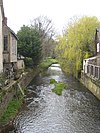This article includes a list of general references, but it lacks sufficient corresponding inline citations .(October 2017) |
The county of Cornwall, located in southwest England in the United Kingdom, contains numerous small rivers and streams. The border between Cornwall and the neighbouring county of Devon is mostly the River Tamar.










































